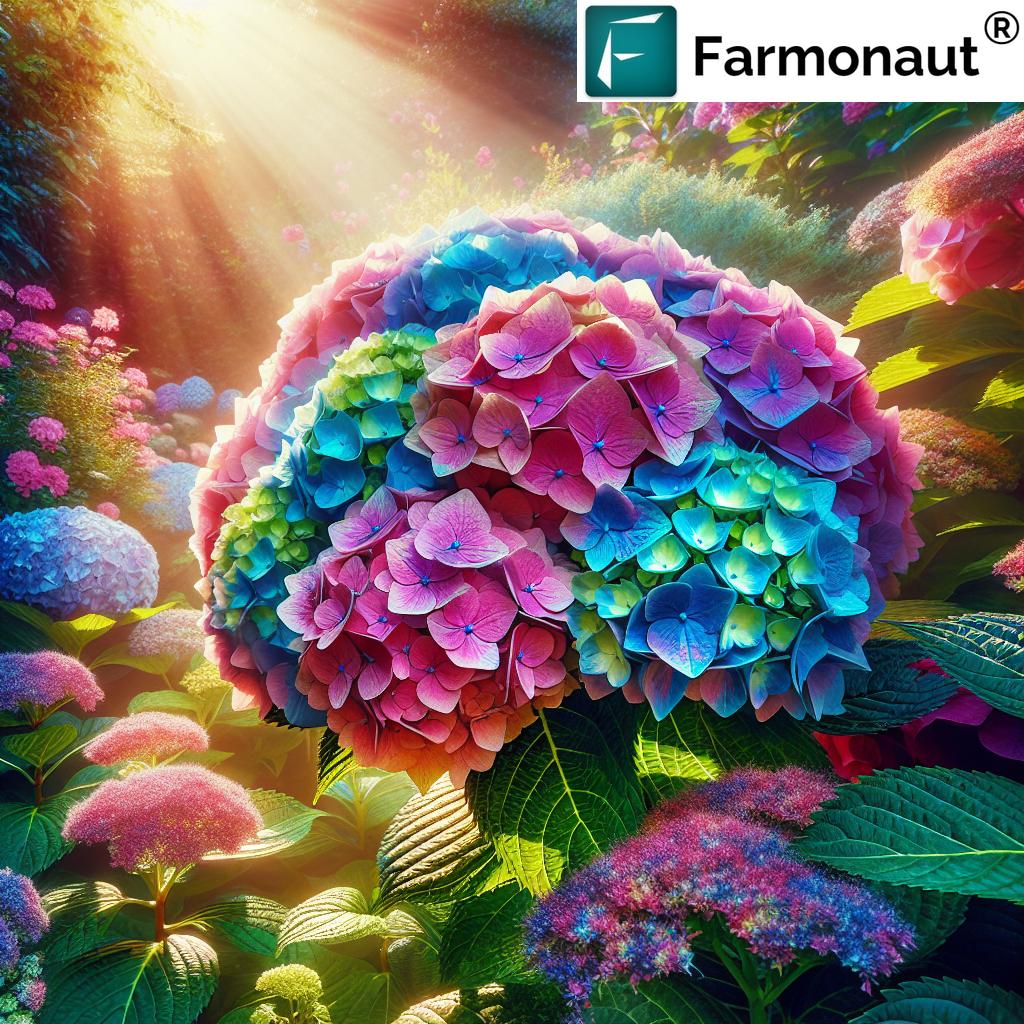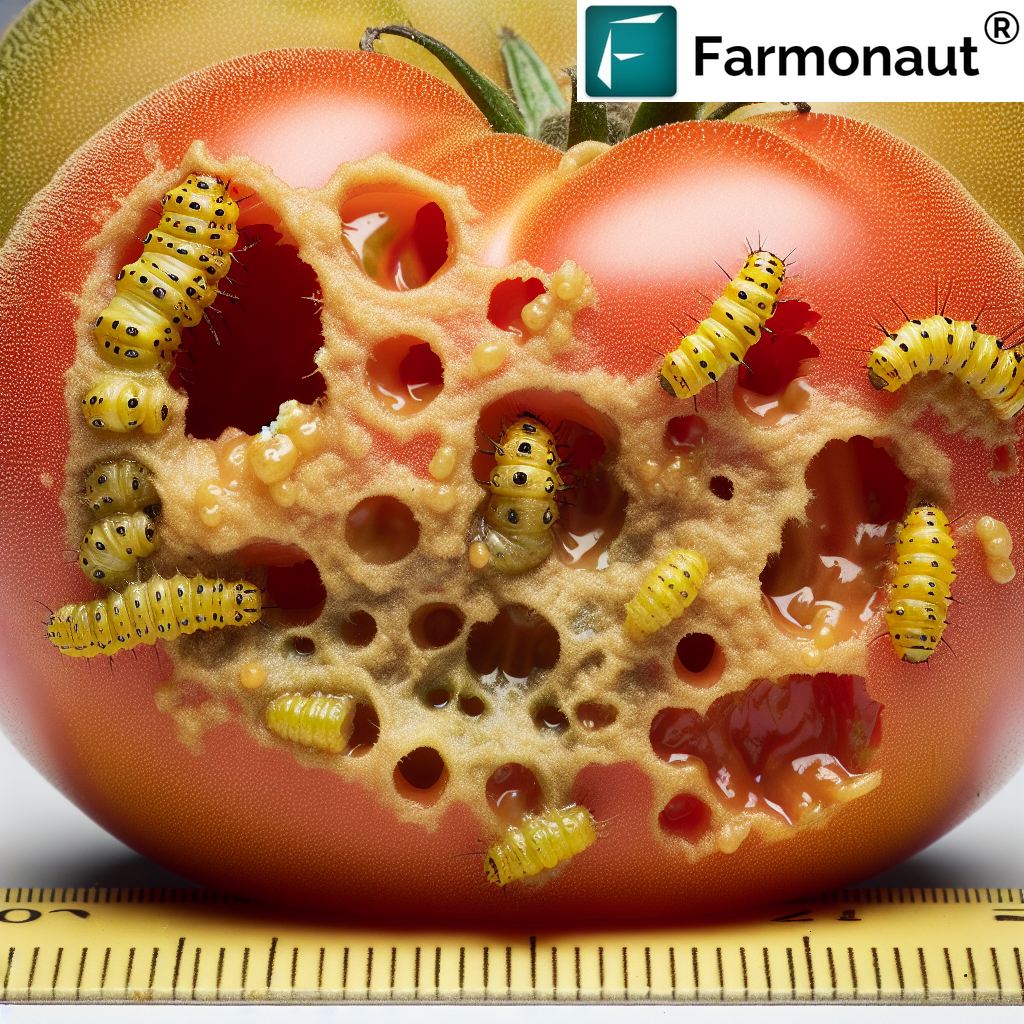
Mastering Hydrangea Care: A Complete Guide to Growing Vibrant Blooms in Your Garden
Hydrangeas are beloved garden shrubs known for their stunning, large flower clusters that can transform any landscape into a colorful oasis. At Farmonaut, we understand the importance of precision in plant care, and we’re excited to share our comprehensive guide on mastering hydrangea care. Whether you’re a seasoned gardener or just starting out, this guide will help you cultivate healthy, vibrant hydrangeas that will be the envy of your neighborhood.
Understanding Hydrangea Varieties
Before diving into care techniques, it’s crucial to understand the different types of hydrangeas. Each variety has unique characteristics and care requirements:
- Bigleaf Hydrangeas (Hydrangea macrophylla): The most common type, known for their large, mophead flowers that change color based on soil pH.
- Panicle Hydrangeas (Hydrangea paniculata): Hardy plants with cone-shaped flower clusters that start white and often turn pink as they age.
- Smooth Hydrangeas (Hydrangea arborescens): Native to North America, these produce large, round flower heads and are very cold-hardy.
- Oakleaf Hydrangeas (Hydrangea quercifolia): Recognized by their oak-like leaves and cone-shaped flower clusters.
- Climbing Hydrangeas (Hydrangea petiolaris): A vine variety that can climb up walls and trellises.
Planting Hydrangeas: Setting the Foundation for Success
Proper planting is crucial for the long-term health and vigor of your hydrangeas. Here’s how to get started:
Choosing the Right Location
Most hydrangeas thrive in areas with:
- Morning sun and afternoon shade
- Well-draining soil
- Protection from strong winds
Using Farmonaut’s satellite monitoring capabilities, you can analyze your garden’s sunlight exposure and soil moisture levels to find the perfect spot for your hydrangeas. Our technology provides real-time data on these crucial factors, ensuring optimal placement for your plants.
Preparing the Soil
Hydrangeas prefer rich, well-draining soil. Follow these steps to prepare your planting site:
- Test the soil pH using a home testing kit or through a professional service.
- Amend the soil with organic matter like compost to improve drainage and nutrient content.
- If necessary, adjust the pH:
- For pink flowers in bigleaf varieties, aim for a pH of 6.0-6.2
- For blue flowers, lower the pH to 5.2-5.5
Farmonaut’s soil analysis tools can help you monitor soil conditions over time, allowing you to make informed decisions about soil amendments and pH adjustments.
Planting Process
- Dig a hole twice the width of the root ball and just as deep.
- Place the plant in the hole, ensuring the top of the root ball is level with the soil surface.
- Backfill with soil, firming gently to eliminate air pockets.
- Water thoroughly to help the soil settle around the roots.
Remember, proper spacing is crucial for hydrangeas. Most varieties need about 3-5 feet of space between plants to accommodate their mature size.
Watering: The Key to Hydrangea Health
Proper watering is essential for hydrangeas, as their name suggests (“hydra” means water in Greek). These plants have high water requirements, especially during their active growing season.
Watering Guidelines
- Water deeply and regularly, especially during the first two growing seasons as the plant establishes its root system.
- Aim to keep the soil consistently moist but not waterlogged.
- Water at the base of the plant to avoid wetting the leaves, which can lead to fungal diseases.
- Use mulch to help retain soil moisture and regulate temperature.
Farmonaut’s soil moisture monitoring can be incredibly helpful in maintaining optimal hydration for your hydrangeas. Our satellite-based technology provides real-time data on soil moisture levels, allowing you to adjust your watering schedule accordingly and prevent both under and overwatering.
Signs of Improper Watering
Underwatering:
- Wilting leaves, especially in the afternoon
- Dry, crispy leaf edges
- Slow growth
Overwatering:
- Yellowing leaves
- Soft, mushy stems near the base
- Root rot (if severe)
Fertilizing: Nourishing Your Hydrangeas for Optimal Growth
Proper fertilization is crucial for promoting healthy growth and abundant blooms in hydrangeas. However, it’s important to strike a balance, as over-fertilizing can lead to excessive leafy growth at the expense of flowers.
When to Fertilize
- Apply a slow-release, balanced fertilizer in early spring as new growth begins.
- For reblooming varieties, you may want to apply a second light feeding after the first bloom cycle.
- Avoid fertilizing after August, as this can stimulate new growth that may be damaged by early frosts.
Choosing the Right Fertilizer
Select a fertilizer based on your hydrangea’s needs and your soil conditions:
- A balanced 10-10-10 fertilizer works well for most hydrangeas.
- If you’re aiming for specific flower colors in bigleaf hydrangeas, choose a fertilizer that helps maintain the desired soil pH.
- Organic options like compost or well-rotted manure can provide nutrients while improving soil structure.
Farmonaut’s satellite monitoring can help you track your hydrangeas’ growth and health, allowing you to adjust your fertilization strategy based on real-time data. Our technology can detect early signs of nutrient deficiencies, enabling you to address issues before they become severe.
Application Tips
- Always water your hydrangeas thoroughly before applying fertilizer.
- Spread the fertilizer evenly around the drip line of the plant, avoiding the stem.
- Work the fertilizer into the top layer of soil and water again to help it reach the roots.
- Follow package instructions for proper dosage to avoid over-fertilization.
Pruning: Shaping Your Hydrangeas for Beauty and Health
Proper pruning is essential for maintaining the shape, size, and blooming potential of your hydrangeas. However, the timing and method of pruning vary depending on the hydrangea variety.
Pruning Guidelines by Variety
Bigleaf Hydrangeas (H. macrophylla) and Mountain Hydrangeas (H. serrata):
- Prune immediately after flowering, usually in late summer.
- Remove dead or weak stems and trim back overgrown branches.
- Avoid heavy pruning, as these varieties bloom on old wood.
Panicle Hydrangeas (H. paniculata) and Smooth Hydrangeas (H. arborescens):
- Prune in late winter or early spring before new growth begins.
- These varieties bloom on new wood, so you can cut them back more severely if needed.
Oakleaf Hydrangeas (H. quercifolia):
- Require minimal pruning, mainly to remove dead or damaged wood.
- If needed, prune immediately after flowering.
Climbing Hydrangeas (H. petiolaris):
- Prune after flowering to control size and shape.
- Remove dead or damaged stems as needed.
General Pruning Tips
- Always use clean, sharp pruning tools to make clean cuts and prevent disease transmission.
- Remove any dead, diseased, or crossing branches first.
- Cut back to just above a set of healthy buds.
- Avoid removing more than one-third of the plant’s total growth in a single season.
Farmonaut’s advanced imaging technology can help you monitor your hydrangeas’ growth patterns and overall health, providing valuable insights to inform your pruning decisions. Our satellite data can show you which areas of your plants may need attention, allowing for more targeted and effective pruning.
Managing Hydrangea Blooms: Enhancing Color and Longevity
The stunning flower clusters of hydrangeas are their main attraction. Understanding how to manage and enhance these blooms can take your hydrangea garden to the next level.
Influencing Flower Color
For bigleaf hydrangeas (H. macrophylla), you can influence the flower color by adjusting soil pH:
- Blue flowers: Aim for a soil pH of 5.2-5.5. Add aluminum sulfate or garden sulfur to lower pH.
- Pink flowers: Strive for a pH of 6.0-6.2. Add garden lime to raise pH.
- Purple flowers: These occur in the transitional pH range between blue and pink (around 5.5-6.0).
Note that white hydrangea varieties are not affected by soil pH and will remain white regardless of soil conditions.
Farmonaut’s soil analysis tools can help you monitor and adjust soil pH over time, ensuring you achieve and maintain the desired conditions for your preferred flower colors.
Encouraging More Blooms
- Ensure proper sunlight exposure (morning sun and afternoon shade for most varieties).
- Maintain consistent soil moisture throughout the growing season.
- Fertilize appropriately, but avoid over-fertilizing with nitrogen, which can promote leafy growth at the expense of flowers.
- Prune at the right time for your hydrangea variety to avoid removing flower buds.
Extending Bloom Time
- Deadhead spent blooms regularly to encourage continued flowering in reblooming varieties.
- Consider planting different hydrangea varieties that bloom at different times to extend the overall flowering period in your garden.
- Provide protection from harsh afternoon sun to prevent blooms from fading too quickly.
Dealing with Common Hydrangea Issues
Even with the best care, hydrangeas can sometimes face challenges. Here are some common issues and how to address them:
Pests
- Aphids: Spray with a strong stream of water or use insecticidal soap.
- Spider Mites: Increase humidity and use miticides if infestation is severe.
- Scale Insects: Prune affected areas and apply horticultural oil.
Diseases
- Powdery Mildew: Improve air circulation and apply fungicides if necessary.
- Leaf Spot: Remove affected leaves and avoid overhead watering.
- Root Rot: Improve drainage and reduce watering frequency.
Environmental Issues
- Wilting: Often due to underwatering or excessive heat. Water deeply and provide shade if needed.
- Yellowing Leaves: Could indicate nutrient deficiency or overwatering. Adjust fertilization and watering practices accordingly.
- Frost Damage: Protect plants with covers during late spring frosts and avoid pruning until new growth appears.
Farmonaut’s advanced monitoring systems can help detect early signs of stress in your hydrangeas, allowing you to address issues before they become severe. Our satellite imagery and AI-powered analysis can identify changes in plant health, helping you pinpoint and resolve problems quickly.
Seasonal Care for Hydrangeas
Proper care throughout the year ensures your hydrangeas remain healthy and vibrant. Here’s a seasonal guide to hydrangea care:
Spring
- Remove winter protection as temperatures warm.
- Prune varieties that bloom on new wood (panicle and smooth hydrangeas).
- Apply a slow-release fertilizer as new growth begins.
- Mulch around the base of the plant to retain moisture and suppress weeds.
Summer
- Water deeply and regularly, especially during dry spells.
- Deadhead spent blooms to encourage continued flowering in reblooming varieties.
- Monitor for pests and diseases, addressing any issues promptly.
- Prune varieties that bloom on old wood after flowering (bigleaf and oakleaf hydrangeas).
Fall
- Reduce watering as temperatures cool and growth slows.
- Stop fertilizing to allow plants to prepare for dormancy.
- Clean up fallen leaves and debris to prevent disease.
- Consider leaving dried flower heads for winter interest and protection.
Winter
- Apply a thick layer of mulch around the base of the plant for insulation.
- Protect plants from harsh winds and heavy snow loads.
- Avoid pruning most varieties during winter dormancy.
- Plan for the upcoming growing season, including any desired changes to your hydrangea garden.
Farmonaut’s year-round monitoring capabilities can provide valuable insights into your hydrangeas’ health and growth patterns throughout the seasons. Our technology can help you track changes in soil moisture, temperature, and plant vigor, allowing you to adjust your care routine as needed for optimal results.
Hydrangeas in Container Gardens
Growing hydrangeas in containers can be a great option for those with limited garden space or for adding versatility to your landscape design. Here are some tips for successful container gardening with hydrangeas:
Choosing the Right Container
- Select a pot that is at least 18-20 inches in diameter and has drainage holes.
- Consider the mature size of your hydrangea variety when selecting a container.
- Use a high-quality potting mix that retains moisture while allowing for good drainage.
Container Care Tips
- Water more frequently than in-ground plants, as containers dry out faster.
- Fertilize regularly with a balanced, water-soluble fertilizer during the growing season.
- Provide winter protection by moving containers to a sheltered area or wrapping them in insulating material.
- Repot every 2-3 years or when the plant outgrows its container.
Farmonaut’s precision monitoring tools can be particularly useful for container gardens, where conditions can change rapidly. Our technology can help you track soil moisture levels and plant health, ensuring your containerized hydrangeas receive optimal care.
Propagating Hydrangeas
Propagating your own hydrangeas can be a rewarding way to expand your garden or share your favorite varieties with friends. Here are two common methods:
Stem Cuttings
- Take 4-5 inch cuttings from soft, new growth in early summer.
- Remove lower leaves, leaving only 2-3 sets of leaves at the top.
- Dip the cut end in rooting hormone.
- Plant in a well-draining potting mix and keep moist.
- Place in a warm, bright location out of direct sunlight.
- Roots should form in 2-3 weeks.
Layering
- Choose a low-growing, flexible stem.
- Make a small wound on the underside of the stem.
- Bend the stem to the ground and cover the wounded area with soil.
- Secure with a landscape pin or small stone.
- Keep the soil moist.
- After roots form (usually in several months), cut the new plant from the parent and transplant.
While Farmonaut’s satellite technology may not directly assist in propagation, our overall plant health monitoring can help ensure your parent plants are in optimal condition for successful propagation.
Companion Planting with Hydrangeas
Hydrangeas can be beautifully complemented by other plants in your garden. Here are some excellent companion plants to consider:
- Hostas: Their lush foliage provides a beautiful contrast to hydrangea blooms.
- Ferns: These shade-loving plants can thrive in similar conditions as hydrangeas.
- Astilbe: Their feathery plumes add texture and complement hydrangea flowers.
- Heuchera: Their colorful foliage can provide year-round interest.
- Boxwood: These evergreen shrubs can provide structure and contrast.
When planning your companion plantings, consider factors such as sunlight requirements, soil preferences, and mature sizes to ensure all plants thrive together.
Hydrangeas in Landscape Design
Hydrangeas are versatile shrubs that can play various roles in landscape design:
- Focal Points: Large hydrangea varieties can serve as stunning focal points in garden beds or as standalone specimens.
- Borders: Create beautiful flowering borders along walkways or property lines.
- Foundation Plantings: Soften the lines of your home’s foundation with hydrangea plantings.
- Woodland Gardens: Many hydrangea varieties thrive in partial shade, making them perfect for woodland garden settings.
- Cut Flower Gardens: Plant hydrangeas specifically for cutting and enjoying indoors.
Farmonaut’s satellite imaging can provide a bird’s-eye view of your property, helping you visualize and plan your hydrangea landscape designs more effectively.

Hydrangea Varieties Comparison Table
| Variety | Soil pH Preference | Sunlight Requirements | Watering Needs | Farmonaut Monitoring Capabilities |
|---|---|---|---|---|
| Bigleaf (H. macrophylla) | 5.2-6.2 (affects flower color) | Morning sun, afternoon shade | High | Soil moisture, pH, sunlight exposure |
| Panicle (H. paniculata) | 5.8-6.2 | Full sun to partial shade | Medium | Soil moisture, sunlight exposure |
| Smooth (H. arborescens) | 6.0-7.0 | Partial to full shade | Medium to High | Soil moisture, shade analysis |
| Oakleaf (H. quercifolia) | 5.0-6.5 | Partial shade | Medium | Soil moisture, shade analysis |
| Climbing (H. petiolaris) | 6.0-7.5 | Partial shade | Medium | Soil moisture, growth tracking |
This table showcases how Farmonaut’s satellite monitoring capabilities can be tailored to the specific needs of different hydrangea varieties, helping gardeners optimize care and bloom production.
Frequently Asked Questions (FAQ)
Q: Why aren’t my hydrangeas blooming?
A: There could be several reasons:
- Improper pruning (cutting off flower buds)
- Insufficient sunlight
- Over-fertilization with high-nitrogen fertilizers
- Late spring frosts damaging flower buds
Farmonaut’s monitoring can help identify issues with sunlight exposure and overall plant health that might be affecting blooming.
Q: How often should I water my hydrangeas?
A: Hydrangeas generally need deep watering 2-3 times a week during the growing season, depending on weather conditions and soil type. Farmonaut’s soil moisture monitoring can provide real-time data to help you optimize your watering schedule.
Q: Can I change the color of my hydrangea flowers?
A: For bigleaf hydrangeas, you can influence flower color by adjusting soil pH. Lower pH (acidic soil) promotes blue flowers, while higher pH (alkaline soil) encourages pink flowers. Farmonaut’s soil analysis tools can help you track and adjust soil pH over time.
Q: When is the best time to transplant hydrangeas?
A: The best time to transplant is in early spring before new growth begins, or in fall after the plant has gone dormant. Avoid transplanting during the heat of summer or when the plant is actively blooming.
Q: How do I protect my hydrangeas in winter?
A:
- Apply a thick layer of mulch around the base of the plant
- Create a protective barrier with burlap or other material for harsh climates
- Avoid pruning late in the season to prevent stimulating new growth
Farmonaut’s temperature monitoring can alert you to potentially damaging cold snaps, allowing you to take timely protective measures.
Q: Why are my hydrangea leaves turning yellow?
A: Yellowing leaves can indicate:
- Overwatering or poor drainage
- Nutrient deficiencies
- Too much direct sunlight
Farmonaut’s plant health monitoring can help detect early signs of stress, allowing you to address issues before they become severe.
Q: Can hydrangeas grow in full sun?
A: While some varieties like panicle hydrangeas can tolerate full sun, most hydrangeas prefer morning sun and afternoon shade. Farmonaut’s sunlight exposure analysis can help you determine the best locations for your hydrangeas based on your specific garden conditions.
Q: How do I deadhead hydrangeas?
A: To deadhead, simply cut off the faded blooms just above the first set of leaves. For reblooming varieties, this can encourage additional flowering throughout the season.
Q: Are hydrangeas deer-resistant?
A: Unfortunately, hydrangeas are not typically deer-resistant and can be attractive to browsing deer. Consider using deer repellents or physical barriers if deer are a problem in your area.
Q: How long do hydrangeas live?
A: With proper care, hydrangeas can live for many years, often decades. Some varieties can even live up to 50 years or more. Regular monitoring and maintenance, which can be assisted by Farmonaut’s technology, can help ensure the longevity of your hydrangeas.
Conclusion
Mastering hydrangea care is a rewarding journey that results in a stunning display of colorful blooms in your garden. By understanding the unique needs of different hydrangea varieties and implementing proper care techniques, you can cultivate healthy, vibrant plants that will be the envy of your neighborhood.
At Farmonaut, we’re committed to helping gardeners and farmers alike achieve success through precision agriculture techniques. Our satellite-based monitoring systems and AI-powered analytics can provide valuable insights into your hydrangeas’ health, growth patterns, and environmental conditions, allowing you to make informed decisions about their care.
Remember, successful hydrangea cultivation is about observation, adaptation, and consistent care. With the right knowledge and tools at your disposal, you can create a thriving hydrangea garden that brings joy year after year.
For more information on how Farmonaut can help you optimize your garden care, visit our website at https://farmonaut.com/app_redirect or download our mobile app on Google Play or the App Store. Happy gardening!













